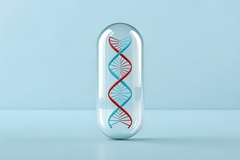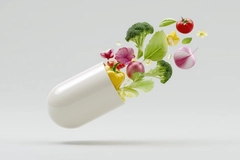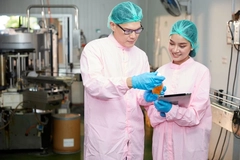Potential of astaxanthin pegged in rising beauty-from-within and nootropics arenas

04 Oct 2019 --- The role for natural astaxanthin in rising arenas such as beauty-from-within and nootropics is emerging, yet strong. Positioned firmly in the healthy aging market, AstaReal experts highlight in a NutritionInsight webinar how the naturally occurring carotenoid not only taps into classic preventative aging categories such as heart and muscle health and vision, but also offers efficacy for newer categories. Adding efficacy for sports nutrition products is also a route full of possibility, they note.
AstaReal’s astaxanthin is based on Haematococcus pluvialis freshwater microalgae. When grown under optimum conditions, the algae is green. However, when exposed to environmental stress, such as high temperatures or low nutrients, the algae start accumulating high concentrations of astaxanthin to provide protection from the harsh environment. To protect the algae’s DNA, lipids and cell structure from UV radiation and other sources of free radicals. The red pigment it produces is astaxanthin.
Dubbed “nature’s most powerful antioxidant,” Andie Long, Sales and Marketing Manager, explains that astaxanthin is 2.6 times stronger than lutein, 110 times stronger than vitamin E and 6000 times stronger than vitamin C.
 Plant-derived ingredients, such as algae-based ones, are growing in popularity.The efficacy of the ingredient is reflected in its market growth. According to Innova Market Insights data, there has been an average annual growth of 18 percent of product launches tracked with astaxanthin, between 2014 and 2018. Among the top ten health claims in products with astaxanthin are eye health, skin health, bone health and muscle health, the market researcher notes.
Plant-derived ingredients, such as algae-based ones, are growing in popularity.The efficacy of the ingredient is reflected in its market growth. According to Innova Market Insights data, there has been an average annual growth of 18 percent of product launches tracked with astaxanthin, between 2014 and 2018. Among the top ten health claims in products with astaxanthin are eye health, skin health, bone health and muscle health, the market researcher notes.
In this way, the ingredient offers a lot in terms of healthy aging. “Younger adults are becoming more conscious about their health and believe that modern lifestyles and diets increase the risk of serious health problems later in life. Senior consumers want to stay as fit and active as possible and maintain a good quality of life – good health is deemed the key way of achieving this,” says Long.
Nootropic growth
Leonhard Thunn-Hohenstein, Key Account Manager, details how nootropics are trending within the supplement space. “Nootropics are substances that may increase cognitive function, such as creativity. Possible target groups are the younger audiences, such as athletes, students and executives. But also seniors who want to stay cognitively resilient.”
“Ingredients include caffeine, which can boost focus, or omega fatty acid DHA (Docosahexaenoic acid) and Medium-chain triglycerides (MCT) for brain health, even CBD for relieving anxiety. Astaxanthin sits very well in this space with its brain-protecting and brain-enhancing properties,” he says.
Brain health claims in food and beverage launches are on the rise, with more than twice as many products (excluding infant nutrition) reported with a brain health claim in 2017 than in 2013, says Innova Market Insights. The market researcher also placed “I Feel Good” among its top ten trends for 2019. This trend denotes a consumer who is interested in active ingredients that can benefit their mood. A preventative approach to aging is gaining traction among consumers.
A preventative approach to aging is gaining traction among consumers.
Indeed, the market research highlights how the energizing aspect of food is increasingly important to consumers as they seek foods that not only nourish but also deliver functional benefits – such as increased concentration. While coffee remains the go-to energy source, natural ingredients are gaining a foothold. This includes astaxanthin.
According to randomized double-blind, placebo-controlled studies, 3 months supplementation of natural astaxanthin (12mg/daily) improved memory, mental quickness and multitasking in senior subjects complaining of age-related forgetfulness. A further study found that of AstaReal astaxanthin led to less mental fatigue and better cognitive performance in healthy men and women 20-64 years old who experience fatigue.
Thunn-Hohenstein highlights astathanxin’s efficacy for keeping the mind sharp. Key areas include fighting mental fatigue, improving age-related forgetfulness and enhancing capillary blood flow in the brain.
Beauty-from-within and functionality with protein
As an outward sign of aging, skin health is a prominent consumer concern.
“What makes natural astaxanthin great for skin health is that it can act on all skin layers. We have a lot of clinical evidence which supports it as a perfect beauty from within ingredient. It supports skin hydration, can support smooth skin, elasticity and reduce age spots and wrinkles,” says Long.
 Brain health claims in food and beverage launches are on the rise.The experts further highlight the “unlimited potential for new product development utilizing natural astaxanthin as a key ingredient to support mitochondrial health.”
Brain health claims in food and beverage launches are on the rise.The experts further highlight the “unlimited potential for new product development utilizing natural astaxanthin as a key ingredient to support mitochondrial health.”
One such area is sports nutrition.
“It’s a great idea to combine protein with natural astaxanthin,” says Thunn-Hohenstein. “Protein is the number one supplement for sports nutrition and we have a lot of studies on how astaxanthin can aid muscle recovery. It is suitable to be combined with different types of protein, such as whey or pea proteins, for example.”
“The target group here can be very diverse. On the one hand, the elderly suffer from age-related muscle loss and the recommended protein intake for this group is already higher. We had the first clinical studies looking at sarcopenia patients, so combining astaxanthin with protein powder makes sense for these groups.”
Innova Market Research data highlights how sports nutrition is the top market category for energy claims. Among food and beverage launches tracked with an energy claims in 2018, sports nutrition reached 38 percent. Also, over one in three products with an energy claim also touts a sports recovery claim.
In this way, combining protein with such an ingredient such as astaxanthin responds to the market needs and trends directly.
You can listen to the full NutritionInsight webinar here.
By Laxmi Haigh












